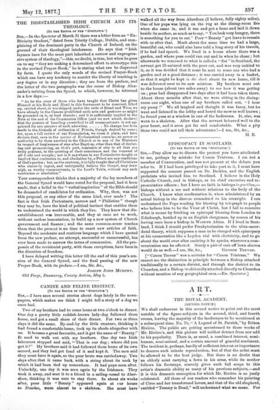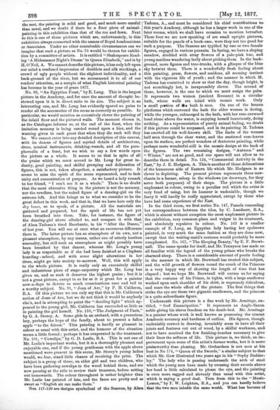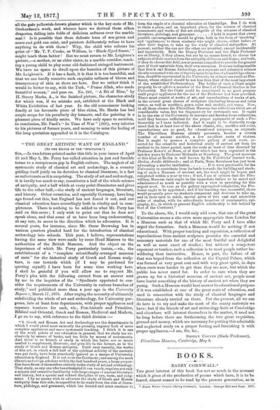ART.
THE ROYAL ACADEMY.
[SECOND NOTICE] WE shall endeavour in this second notice to point out the most notable of the figure-subjects in the second, third, and fourth rooms, leaving the majority of the landscapes to be mentioned at a subsequent time. No. 70, " A Legend of St. Patrick," by Briton Riviere. The public are getting accustomed to these works of Mr. Riviere's, and this picture will neither detract from nor add to his popularity. There is, as usual, a combined interest, semi- human, semi-animal, and a certain amount of graceful sentiment. The incident is, perhaps, hardly of sufficient interest or importance to deserve such minute reproduction, but of that the artist must be allowed to be the best judge. But there is no doubt that an elderly saint carrying a fawn in his arms, while its mother follows his footsteps, scarcely gives such full scope to this artist's dramatic ability as many of his previous subjects,—and it is this dramatic conception for which Mr. Riviere is so justly celebrated. All those of our readers who remember his painting of Circe and her transformed lovers, and that of the old shepherd, entitled" Tommy is Dead," will understand what we mean. For the rest, the painting is solid and good, and much more careful than usual, and we doubt if there be a finer piece of animal- painting in this exhibition than that of the roe and fawn. Next to this is one of those pictures which are, unfortunately, in this exhibition always connected with the names of Royal Academicians or Associates. Under no other conceivable circumstances can we imagine that such a picture as No. 75 would be chosen for exhibi- tion by a committee of artists. It is entitled " Shakespeare Read- ing A Midsummer Night's Dream' to Queen Elizabeth," and is by H. O'Neil, A. We cannot describe this picture, it has only left upon our mind a confused impression of doublets and silk stockings, a crowd of ugly people without the slightest individuality, and a back-ground of the river, but we recommend it to all of our readers' attention, as a sample of what English historical painting has become in the year of grace 1877.
No. 83, "An Egyptian Feast," by E. Long. This is the largest picture in the Academy, and for once the amount of thought be- stowed upon it is in direct ratio to its size. The subject is an interesting one, and Mr. Long has evidently spared no pains to render all the accessories of the scene as correctly as possible. In particular, we would mention as excessively clever the painting of the inlaid floor and the pictured walla. The moment chosen is, as the Catalogue informs us, at the end of the feast, when the imitation mummy is being carried round upon a bier, and the warning given to each guest that when they die such will they be. We cannot enter into any detailed description of this canvas, with its dozens of figures and myriad details of architecture, dress, musical instruments, drinking-vessels, and all the para- phernalia of a feast, but we wish to say a few words upon the picture as a whole. It seems to us that in spite of all the praise which we must accord to Mr. Long for great in- dustry, good painting, and skilful grouping and delineation of figures, this is not, taken altogether, a satisfactory picture. It seems to miss the spirit of the scene represented, and to lack unity and concentration of purpose. As we heard a lady remark to her friend, "I can't see it as a whole." There is no doubt that the most obtrusive thing in the picture is not the mummy, nor the revellers, but the naked figure of a dancing-girl on the extreme left. And this brings us to what we consider to be the great defect in this work, and that is, that we have here only the dry bones, so to speak, of a picture. All the materials are gathered and prepared, but the spirit of life has not yet been breathed into them. Take, for instance, the figure of the dancing-girl above alluded to, and compare it with that of Alma Tadema's tired Bacchante, in his "After the Dance," of last year. You will see at once what an enormous difference there is. The latter picture has an atmosphere of its own, not a pleasant atmosphere, by any means, rather one of utterly heathen sensuality, but still such an atmosphere as might possibly have been breathed by that dancer, whereas Mr. Long's young lady is as respectable as if she had been finished at a Clapham boarding - school, and with some slight alterations in her dress, might go into society to-morrow. Well, this will apply to the whole picture. It is really only an excessively skilful and industrious piece of stage-carpentry which Mr. Long has given us, and as such it deserves the highest praise ; but it is not a great picture, except in so far as it is great for a painter now-a-days to devote so much conscientious care and toil to a worthy subject. No. 91, " Joan of Arc," by P. H. Calderon, R.A. Of this picture we can only say that this is Mr. Calderon's notion of Joan of Arc, but we do not think it would be anybody else's, and in attempting to paint the " dazzling light " which ap- peared to the young girl, Mr. Calderon has succeeded as little as in painting the girl herself. No. 110, "The Judgment of Paris," by G. A. Storey, A. Some girls in an-orchard, with a precocious boy, perhaps the hope of the family, about to present a fallen apple "to the fairest." This painting is hardly so pleasant in colour as usual with this artist, and the humour of the situation seems a little forced ; perhaps it has evaporated in the treatment. No. 101, " Cowslips," by G. D. Leslie, R.A. This is not one of Mr. Leslie's important works, but it is a thoroughly pleasant and enjoyable one, and if the young gentleman with the apple above mentioned were present in this scene, Mr. Storey's young ladies would, we fear, stand little chance of receiving the prize. The subject is a group of three, an elder girl and two children, who have been gathering cowslips in the wood behind them, and are now pausing at the stile to review their treasures, before setting out homewards. The colour throughout is rather brighter than Mr. Leslie has painted of late, and the faces are pretty and as sweet as "English air can make them."
Nos. 117-120 are designs symbolical of the Seasons, by Alma Tadema, A., and must be considered his chief contributions to this year's Academy, although he has a larger work in one of the later rooms, which we shall have occasion to mention hereafter. These four we are now speaking of are small upright pictures, suitable for the panels of a book-case, were they not too good for such a purpose. The Seasons are typified by one or two female figures, engaged in various pursuits. In Spring, we have a sloping meadow, studded with stray flowers of a pale-pink hue, and young maidens wandering lazily about picking them. In the back ground, more figures and tree-trunks, with a glimpse of the blue sky betwixt them. There is a wonderfully fresh feeling about this painting, grass, flowers, and maidens, all seeming instinct with the vigorous life of youth ; and the manner in which M. Tadema has contrived to show us that the day, though bright, is not scorchingly hot, is inexpressibly clever. The second of these, however, is the one to which we must assign the palm, It represents two women (ancient Romans) in a circular- bath, whose walls are inlaid with mosaic work. Only a small portion of Mae bath is seen. On one of the brazen, platforms which surround the bath the older woman is dozing, while the younger, submerged in the bath, with her rose-crowned head alone above the water, is enjoying herself luxuriously, doing nothing. As a representation of purely animal feeling, we doubt if this picture could be surpassed, and in its painting M. Tadema has exerted all his well-known skill. The limbs of the woman half seen through the clear water, and the scattered rose-leaves- upon its surface, are perfect wonders of dexterous painting, while- perhaps more wonderful still is the mosaic design at the back o the figures. The two remaining designs, "Autumn " and " Winter," are not so good, and our space will not allow us to describe them in detail. No. 124, "Commercial Activity in the East," by J. E. Hodgson, A. This is another of those delineations of the humorous side of Eastern life which• Mr. Hodgson is so- clever in depicting. The present picture represents three mer- chants in a bazaar, asleep in the windows (or doorways, for they- serve both purposes) of their shops. The picture is a little- unpleasant in colour, owing to a peculiar red which the artist is- very fond of using; but its humour is undeniable, though we fancy it will hardly be really appreciated, except by those who- have had some experience of the East.
In the third room, we first notice No. 147, Pamela concealing her correspondence between the tiles, by C. Landseer, R.A., which is almost without exception the most unpleasant picture in. the exhibition, very common-place and vulgar in its treatment, and absolutely repulsive in colour. No. 168 is a smaller example of E. Long, an Egyptian lady having her eyebrows painted, in very much the same fashion as they are done now, except that the waiting-maid's costume would probably be more- complicated. No. 167, " The Sleeping Beauty," by E. F. Brewt- nall. The name speaks for itself, and Mr. Tennyson has made us. all familiar with the legend of the young prince who breaks the- charmed sleep. There is a considerable amount of poetic feeling in the manner in which Mr. Brewtnall has treated this subject, and the wild growth of flowers round the couch of the Princess- is a very happy way of showing the length of time that has elapsed ; but we hope Mr. Brewtnall will excuse us for saying that the costume of his Prince, in tights, with a large sunflower worked upon each shoulder of his shirt, is supremely ridiculous,. and mars the whole effect of the picture. The first things that strike the eye are those two gigantic sunflowers, and the princess- is a quite subordinate figure.
Underneath this picture is a fine work by Mr. Armitage, en- titled, " Serf Emancipation." It represents an Anglo-Saxon. noble giving his slaves freedom on his death-bed. Mr. Armitage is a painter whose work is well known as possessing the utmost. Academic accuracy and hardness of outline. His figures, though, undeniably correct in drawing, invariably seem to have all their- joints and features cut out of wood, by a skilful workman, and not to have received the few finishing-touches necessary to give- their lines the softness of life. This picture is, we think, an im- provement upon some of this artist's former works, but it is more- praiseworthy than pleasing. Mr. Orchardson is not seen at his best in No 174, " Queen of the Swords," a similar subject to that which Mr. Gow illustrated two years ago in his " Sophy Badder- ley." The lady who is passing underneath the arch of steel which the young men have made by crossing their swords above her head is little calculated to please the eye, and the painting is even more ragged and slovenly than usual with this artist, which is saying a good deal. Turn from this to the "Music- Lesson," by F. W. Leighton, R.A., and you can hardly believe that the two men inhabit the same world. What has become of
all the pate yellowish-brown plaster which is the key-note of Mr. Orchardeon's work, and whence have we derived these silken draperies, falling into folds of delicious softness over the marble seat ? Is it possible that these delicate hues of sea-green and azure and gold can exist, and painters deliberately refuse to have anything to do with them ? Why, the child who colours his print of " Mr. T. P. Cooke, as William, in Black-Eyed Susan," might teach them better ! But we must return to Mr. Leighton's picture,—a mother, or an elder sister, in a marble corridor, teach- ing a young child to play some old-fashioned stringed instrument. We have no space to dwell upon the beauties of this picture of Mr. Leighton's. If it has a fault, it is that it is too beautiful, and that we can hardly conceive such exquisite softness of bloom and transparency of skin as there are here. But we rather think it would be better to say, with the Turk, " Praise Allah, who made beautiful women," and pass on. No. 246, "A Bit of Blue," by H. Stacey Marks, A., is the finished picture, the character-study for which was, if we mistake not, exhibited at the Black and White Exhibition of last year. In the old connoisseur looking fondly at his favourite piece of blue china, Mr. Marks has had ample scope for his peculiarly dry humour, and the painting is a pleasant piece of kindly satire. We have only space to mention, in conclusion, Mr. Faed's " In Time of War " (266), very inferior to, his pictures of former years, and seeming to miss the feeling of the long quotation appended to it in the Catalogue.




































 Previous page
Previous page